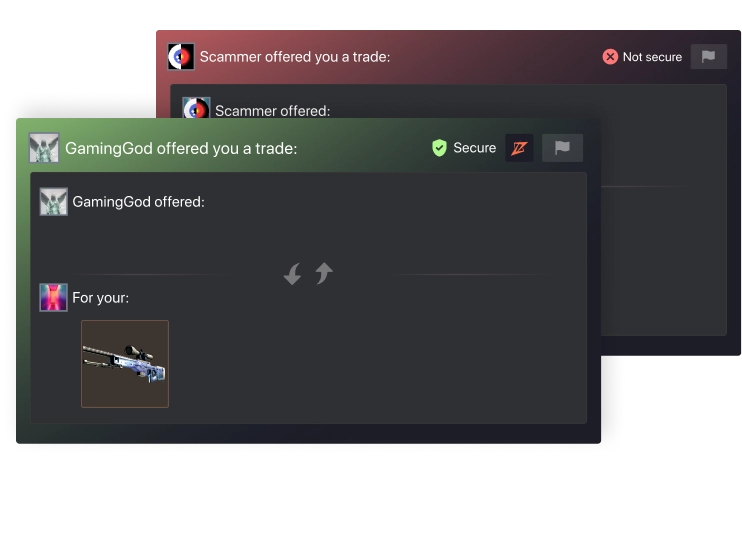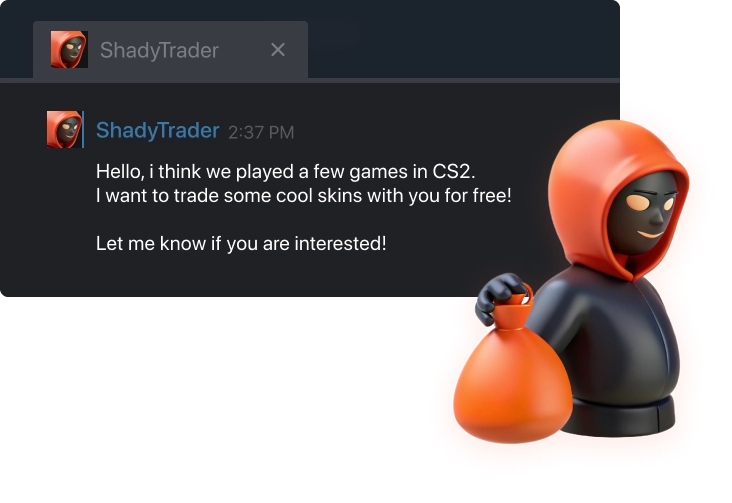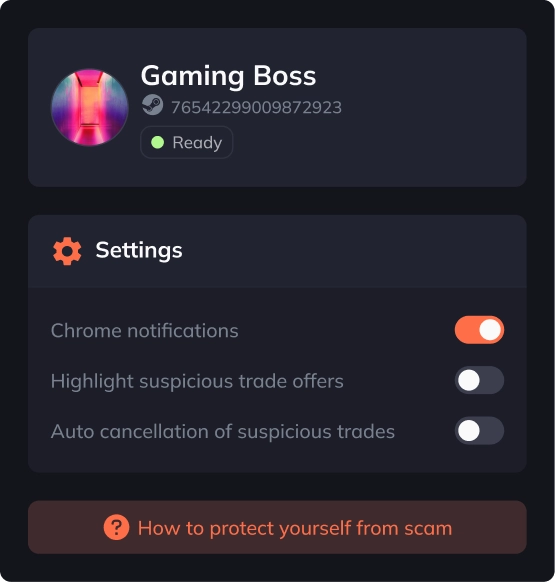What is a CS2 (CS:GO) Trade Scam?
A CS2 (CS:GO) trade scam is a deceptive act that involves gaining access to items, currency, or personal information from unaware traders. Within CS2 (CS:GO), most of the scams are actually targeting those players in search of trading or selling their skins, causing tremendous monetary and emotional harm. Scammers employ methods such as impersonation, phishing, or API manipulation when tricking players into giving up their items.



How Do CS2 (CS:GO) Trade Scams Work?
Generally, trade scams in CS2 (CS:GO) make use of the trust factor between traders or exploit complexities found in trading. Scammers may impersonate trusted figures, use fake websites imitating actual trading platforms, and are known to heap pressure on their victims to make hasty decisions or distract them from the right deals through misleading information in a bid to steal their items.
The Anatomy of a Scam
Scams often follow a predictable pattern. First, the scammer identifies a target - usually someone who has valuable skins or is eager to trade. They then engage the target in conversation, often pretending to be someone trustworthy. Through charm or intimidation, the scammer convinces the target to part with their items under false pretenses. Finally, once the scammer has what they want, they disappear, leaving the victim without recourse.

What Are The Most Common CS2 (CS:GO) Scams?
Understanding common scams can help you recognize and avoid them. Here are some prevalent CS2 (CS:GO) scams:
Phishing Scam
Phishing scams involve fake websites or messages to trick you into submitting your Steam credentials. Once the scammers get access to your Steam account, they will steal your items and personal information. Always check the URL and make sure you are on the official Steam website before filling in your credentials.
CS2 (CS:GO) Website Scam
CS2 website scams are trading websites that are specifically created to scam people's items or accounts. Such websites often take the form of legitimate websites but are really forged websites just to deceive the users. To determine if a website is legitimate, you need to check the URL and look for some reviews about it.
Impersonation Scams
Perhaps the most common tactic is pretending to be a popular trader or friend and somehow finding a way to get you to trade your items away with malicious intent. In many cases, they will even go the extra mile of creating fake profiles that look exactly like those of a reputable trader. Double-check their usernames and profile information before hitting that "Accept" button on a trade offer.
API Scam
An API scam is another third-party service that operates by means of Steam accounts. The scammer may use such services to route the transfer of your item to their account. Be cautious while allowing third-party applications to use and make sure they are from a trusted source.
Trade Scams
These scams occur during a trade. For instance, a scammer could send an offer and then at the last moment change it up, leaving you with low-value skins. Always, always read over the details of a trade before accepting it.
Steam Gift Card Scam
In the Steam gift card scam, you are requested to switch your items for their cards. But once you send your items, the scammer disappears without giving you the cards promised to you. It's crucial to stay vigilant and only engage in trades with trusted parties.
CS2 (CS:GO) Trading Bot Scam
In a Trading bot scam, bots pretend to be real traders. Sometimes, they can even pretend to act just like real people in order to make you think that the trade is legitimate. The bots in question may go so far as to switch items or tinker with trade offers right before trading. Always double-check trades on your own end to keep this from happening to you.
Item Swap Scam
Scammers will make you believe in switching some items with them temporarily, but they will eventually disappear with those valuable skins of yours. Never fall for any skin trade if you are willing to lose those permanently.
CS2 (CS:GO) Trading PayPal Scam
In CS2 (CS:GO) trading PayPal scam, the scammer is going to offer you payment through PayPal once you send your items out. Only for that payment never to materialize. Make sure every transaction is safe by doing it inside the safety of the Steam market or via a known paying source.
SSFN File Scam
In this type of scam, the user is fooled into sharing the SSFN file with him. This file is critical, as a user logging in without authorization is verified through this file by Steam. As it can be misused for gaining unauthorized entry into your account, secure your SSFN file.
How to Avoid Scams When Trading Items?
Avoiding scams requires vigilance and knowledge of secure trading practices. Here are some tips to keep your trades safe:
Secure Trading Practices
Use Trusted Platforms: Only trade on platforms you trust, like Steam or SkinPlace. Avoid unknown trading sites that offer too-good-to-be-true deals. Trusted platforms have security measures in place to protect users.
Enable Two-Factor Authentication: Protect your Steam account with two-factor authentication to prevent unauthorized access. This adds an extra layer of security that can help deter unauthorized login attempts
Research and Verification
Verify Trade Offers: Double-check the details of a trade offer. Be sure that everything being exchanged for has all the conditions agreed upon.
Research Traders: Check reputation and feedback for the traders you're dealing with; be extra cautious with new or low-reputation accounts
How SkinPlace Prevents CS2 (CS:GO) Trading Scams
At SkinPlace, we prioritize your security with several anti-scam measures:At SkinPlace, we prioritize your security with several anti-scam measures:

Automatic Trade Cancellation:
Our system automatically cancels trades marked as potential scams. It has Steam notifications on the trade page with the bot Steam ID and our logo, and it is very transparent to users
Steam Trade Page Notifications:
We display critical information on the Steam trade page, including the bot's Steam ID and our logo, ensuring transparency. Users can easily verify the authenticity of trade offers through visual confirmations
Trade URL Checker:
Our system automatically cancels trades marked as potential scams. It has Steam notifications on the trade page with the bot Steam ID and our logo, and it is very transparent to users
Trade URL Checker:
Verify the links here before you check if they're safe to trade; Click green marked identifiers, the bot marked yellow for moderate risk, and red for scam
Real-Life Examples of CS2 (CS:GO) Scams
Learning from real-life examples can help you better understand the tactics scammers use. Here are a few common scenarios:

The Fake Giveaway
Scammers announce fake giveaways, requiring you to enter your Steam credentials to participate. Once you provide your login details, the scammer gains access to your account. To avoid this, never enter your credentials on sites claiming to offer free items

The Urgent Trade
A scammer poses as a friend in urgent need, requesting a trade to "borrow" items for a tournament or event. They promise to return the items immediately but disappear once the trade is completed. Always verify the identity of the requester and question any urgency that seems suspicious

The Price Manipulator
Scammers manipulate market prices by artificially inflating the value of an item. They convince you to trade for these overpriced items, only for the market value to crash once the scam is complete. Research current market trends and verify item values before agreeing to trades

Reporting Scammers and Seeking Support
If you encounter a scam, report it immediately to Steam Support and relevant trading platforms. Providing detailed information about the scammer can help prevent future incidents. Here's how to report effectively:
Gather Evidence:
Take screenshots of all communications, trade offers, and relevant details. Documenting evidence can strengthen your report and assist investigators
Report on Platforms:
Use the reporting tools on Steam and trading sites to alert them of the scammer. Include as much detail as possible to aid in their investigation
Enhance Your Security with the CS2 Trader Extension
To ensure your CS2 (CS:GO) trading experience is safe, consider using our CS2 Trader Extension, designed specifically to protect you from potential scams. This tool acts as an extra layer of security by verifying the authenticity of trade offers and identifying suspicious activity before you finalize any transactions.
Whether you're dealing with trading bots, unfamiliar users, or high-stakes trades, our extension helps you stay one step ahead of scammers by providing real-time alerts and comprehensive safety checks.
Equip yourself with this essential tool to trade with confidence and safeguard your valuable items from falling into the wrong hands.

CS2 (CS:GO) Trade Scams FAQ
- Avoid trades with unknown users, offers that seem too good to be true, off-platform trades, middleman trades, and those involving items that aren't clearly described.

